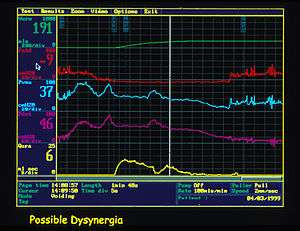Bladder sphincter dyssynergia
| Bladder sphincter dyssynergia | |
|---|---|
|
Urodynamic trace of detrusor sphincter dyssynergia | |
| Classification and external resources | |
| ICD-9-CM | 596.55 |
Bladder sphincter dyssynergia (also known as detrusor sphincter dysynergia (DSD) (the ICS standard terminology agreed 1998) [1] and neurogenic detrusor overactivity (NDO)) is a consequence of a neurological pathology such as spinal injury [2] or multiple sclerosis.[3] which disrupts central nervous system regulation of the micturition (urination) reflex resulting in dyscoordination of the detrusor muscles of the bladder and the male or female external urethral sphincter muscles. In normal lower urinary tract function, these two separate muscle structures act in synergistic coordination. But in this neurogenic disorder, the urethral sphincter muscle, instead of relaxing completely during voiding, dyssynergically contracts causing the flow to be interrupted and the bladder pressure to rise.[4]
Pathology and symptoms
The pathophysiology of the condition results from neuronal plasticity associated with bladder afferents and motor neurons innervating the external urethral sphincter. People with this condition generally experience daytime and night time wetting, urinary retention, and often have a history of urinary tract and bladder infections. Constipation and encopresis are often associated with this condition.
Treatment
Botulinum A toxin is a valuable alternative for patients who do not want surgical methods.[5]
References
- ↑ Manfred Stohrer; et al. (1999). "The Standardization of Terminology in Neurogenic Lower Urinary Tract Dysfunction". Neurourology and Urodynamics. 18 (2): 139–158. doi:10.1002/(SICI)1520-6777(1999)18:2<139::AID-NAU9>3.0.CO;2-U. PMID 10081953.
- ↑ Karsenty G; et al. (2005). "Understanding detrusor sphincter dyssynergia--significance of chronology". Urology. 66 (4): 763–8. doi:10.1016/j.urology.2005.04.061. PMID 16230135.
- ↑ E Iu Stankovich; V V Borisov; T L Demina (1999). "Tamsulosin in the treatment of detrusor-sphincter dyssynergia of the urinary bladder in patients with multiple sclerosis". Urologiia: 48–51. ISSN 1728-2985. Urination disorders occur in 80% patients with multiple sclerosis (MS). The most common of them is detrusor-sphincter dyssynergia (DSD),
- ↑ Corcos, Jacques; Schick, Erik (2004). Textbook of the neurogenic bladder: adults and children. Informa Health Care. pp. 163–168. ISBN 1-84184-206-0.
- ↑ http://jnnp.bmj.com/content/63/4/474.full
Further reading
- Lester M. Libo (1983). "EMG biofeedback for functional bladder-sphincter dyssynergia: A case study". Applied Psychophysiology and Biofeedback. 8.
External links
- Pressure Flow Study, Department of Urology, Southern General Hospital, Glasgow
